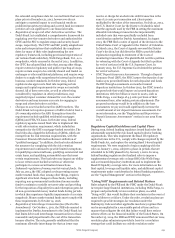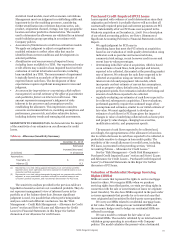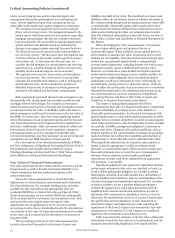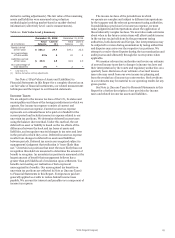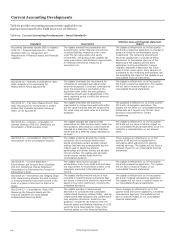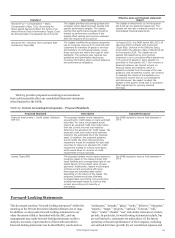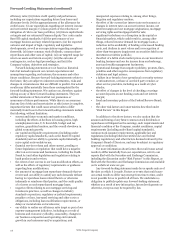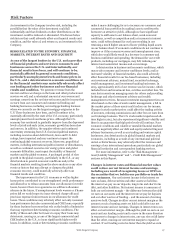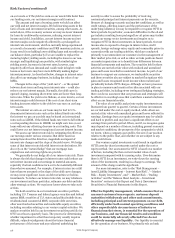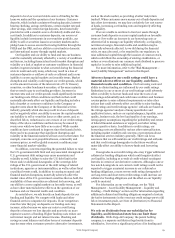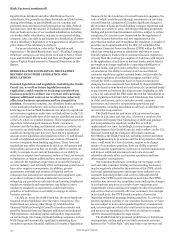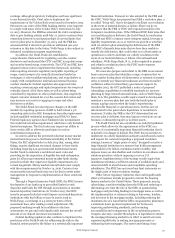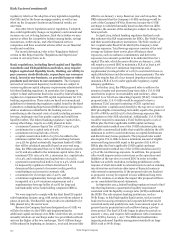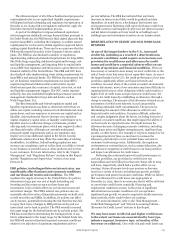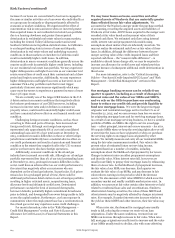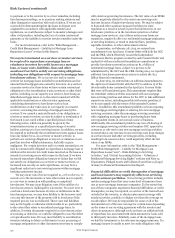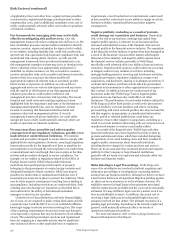Wells Fargo 2015 Annual Report Download - page 121
Download and view the complete annual report
Please find page 121 of the 2015 Wells Fargo annual report below. You can navigate through the pages in the report by either clicking on the pages listed below, or by using the keyword search tool below to find specific information within the annual report.deposits to be a low cost and stable source of funding for the
loans we make and the operation of our business. Customer
deposits, which include noninterest-bearing deposits, interest-
bearing checking, savings certificates, certain market rate and
other savings, and certain foreign deposits, have historically
provided us with a sizeable source of relatively stable and low-
cost funds. In addition to customer deposits, our sources of
liquidity include investments in our securities portfolio, our
ability to sell or securitize loans in secondary markets and to
pledge loans to access secured borrowing facilities through the
FHLB and the FRB, and our ability to raise funds in domestic
and international money through capital markets.
Our liquidity and our ability to fund and run our business
could be materially adversely affected by a variety of conditions
and factors, including financial and credit market disruption and
volatility or a lack of market or customer confidence in financial
markets in general similar to what occurred during the financial
crisis in 2008 and early 2009, which may result in a loss of
customer deposits or outflows of cash or collateral and/or our
inability to access capital markets on favorable terms. Market
disruption and volatility could impact our credit spreads, which
are the amount in excess of the interest rate of U.S. Treasury
securities, or other benchmark securities, of the same maturity
that we need to pay to our funding providers. Increases in
interest rates and our credit spreads could significantly increase
our funding costs. Other conditions and factors that could
materially adversely affect our liquidity and funding include a
lack of market or customer confidence in the Company or
negative news about the Company or the financial services
industry generally which also may result in a loss of deposits
and/or negatively affect our ability to access the capital markets;
our inability to sell or securitize loans or other assets, and, as
described below, reductions in one or more of our credit ratings.
Many of the above conditions and factors may be caused by
events over which we have little or no control. While market
conditions have continued to improve since the financial crisis,
there can be no assurance that significant disruption and
volatility in the financial markets will not occur in the future. For
example, concerns over geopolitical issues, commodity and
currency prices, as well as global economic conditions, may
cause financial market volatility.
In addition, concerns regarding the potential failure to raise
the U.S. government debt limit and any associated downgrade of
U.S. government debt ratings may cause uncertainty and
volatility as well. A failure to raise the U.S. debt limit in the
future and/or additional downgrades of the sovereign debt
ratings of the U.S. government or the debt ratings of related
institutions, agencies or instrumentalities, as well as other fiscal
or political events could, in addition to causing economic and
financial market disruptions, materially adversely affect the
market value of the U.S. government securities that we hold, the
availability of those securities as collateral for borrowing, and
our ability to access capital markets on favorable terms, as well
as have other material adverse effects on the operation of our
business and our financial results and condition.
As noted above, we rely heavily on bank deposits for our
funding and liquidity. We compete with banks and other
financial services companies for deposits. If our competitors
raise the rates they pay on deposits our funding costs may
increase, either because we raise our rates to avoid losing
deposits or because we lose deposits and must rely on more
expensive sources of funding. Higher funding costs reduce our
net interest margin and net interest income. Checking and
savings account balances and other forms of customer deposits
may decrease when customers perceive alternative investments,
such as the stock market, as providing a better risk/return
tradeoff. When customers move money out of bank deposits and
into other investments, we may lose a relatively low cost source
of funds, increasing our funding costs and negatively affecting
our liquidity.
If we are unable to continue to fund our assets through
customer bank deposits or access capital markets on favorable
terms or if we suffer an increase in our borrowing costs or
otherwise fail to manage our liquidity effectively, our liquidity,
net interest margin, financial results and condition may be
materially adversely affected. As we did during the financial
crisis, we may also need, or be required by our regulators, to
raise additional capital through the issuance of common stock,
which could dilute the ownership of existing stockholders, or
reduce or even eliminate our common stock dividend to preserve
capital or in order to raise additional capital.
For more information, refer to the “Risk Management –
Asset/Liability Management” section in this Report.
Adverse changes in our credit ratings could have a
material adverse effect on our liquidity, cash flows,
financial results and condition. Our borrowing costs and
ability to obtain funding are influenced by our credit ratings.
Reductions in one or more of our credit ratings could adversely
affect our ability to borrow funds and raise the costs of our
borrowings substantially and could cause creditors and business
counterparties to raise collateral requirements or take other
actions that could adversely affect our ability to raise funding.
Credit ratings and credit ratings agencies’ outlooks are based on
the ratings agencies’ analysis of many quantitative and
qualitative factors, such as our capital adequacy, liquidity, asset
quality, business mix, the level and quality of our earnings,
rating agency assumptions regarding the probability and extent
of federal financial assistance or support, and other rating
agency specific criteria. In addition to credit ratings, our
borrowing costs are affected by various other external factors,
including market volatility and concerns or perceptions about
the financial services industry generally. There can be no
assurance that we will maintain our credit ratings and outlooks
and that credit ratings downgrades in the future would not
materially affect our ability to borrow funds and borrowing
costs.
Downgrades in our credit ratings also may trigger additional
collateral or funding obligations which could negatively affect
our liquidity, including as a result of credit-related contingent
features in certain of our derivative contracts. Although a one or
two notch downgrade in our current credit ratings would not be
expected to trigger a material increase in our collateral or
funding obligations, a more severe credit rating downgrade of
our long-term and short-term credit ratings could increase our
collateral or funding obligations and the effect on our liquidity
could be material.
For information on our credit ratings, see the “Risk
Management – Asset/Liability Management – Liquidity and
Funding – Credit Ratings” section and for information regarding
additional collateral and funding obligations required of certain
derivative instruments in the event our credit ratings were to fall
below investment grade, see Note 16 (Derivatives) to Financial
Statements in this Report.
We rely on dividends from our subsidiaries for
liquidity, and federal and state law can limit those
dividends. Wells Fargo & Company, the parent holding
company, is a separate and distinct legal entity from its
subsidiaries. It receives a significant portion of its funding and
Wells Fargo & Company
119


